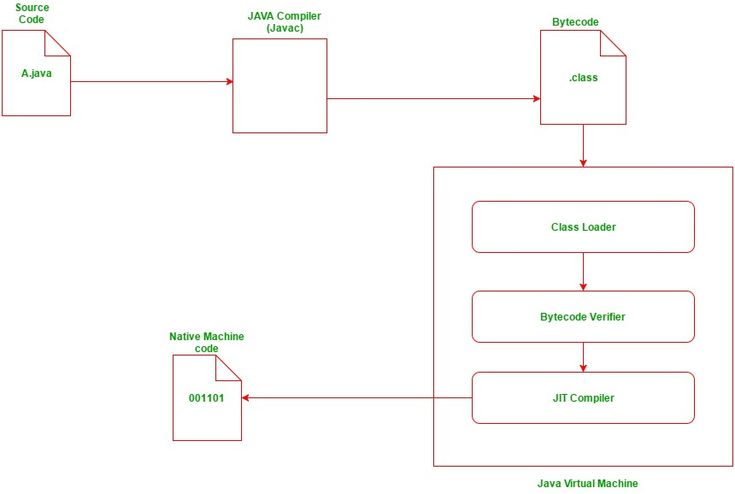Introduction to Java : A Brief Overview ...
 Akash Das
Akash Das
Before diving into the world of Java, I will give a brief overview of what a programming language is and how it helps us communicate with a machine.
What is a Programming Language?
A programming language is a structured system designed to instruct computers to execute specific tasks. It comprises a set of rules and syntax that allow programmers to write code, which the machine can then translate into actions. Programming languages act as a bridge between human concepts and computer operations, facilitating communication between humans and machines.
Programming languages can be categorized based on their level of abstraction from the hardware. Here are the main categories:
High -Level Programming Languages :
These languages are closer to human languages and further from machine code. They are designed to be easy to read and write, and they handle much of the complexity of the hardware. Examples include Java, Python, C++, and JavaScript. High-level languages are generally used for application development because they allow developers to write code more quickly and with fewer errors.
Low-Level Programming Language :
These languages are closer to machine code and provide little or no abstraction from a computer's instruction set architecture. They are more difficult to read and write but offer greater control over hardware. Examples include Assembly language and machine code. Low-level languages are often used for system programming and performance-critical applications where direct hardware manipulation is necessary.
Mid-Level Programming Languages: These languages provide a balance between high-level and low-level programming. They offer some abstraction while still allowing for hardware manipulation. An example is C, which provides low-level memory access while still being more readable than Assembly.
What is Java ?

Java is a high-level, object-oriented programming language that was developed by Sun Microsystems in 1995. Imagine Java as a universal translator that allows you to write code once and run it anywhere. This is possible because of the Java Virtual Machine (JVM), which interprets the Java code and translates it into machine-specific instructions.
Java is known for its simplicity, portability, and robustness, making it a popular choice for building web applications, mobile applications, and large-scale enterprise systems. The language emphasizes readability and ease of use, which helps developers write clear and maintainable code. Java's extensive standard library and strong community support further enhance its versatility and appeal.
Key Features of Java:
Platform Independence: One of Java's most significant advantages is its platform independence. The slogan "Write Once, Run Anywhere" (WORA) encapsulates this feature. Java programs are compiled into bytecode, which can be executed on any device equipped with a Java Virtual Machine (JVM).
Object-Oriented: Java is built on the principles of object-oriented programming (OOP), which promotes code reuse, scalability, and maintainability. Key OOP concepts such as inheritance, encapsulation, and polymorphism are integral to Java.
Robust and Secure: Java provides strong memory management and exception handling features, which contribute to its robustness. Additionally, Java has built-in security features, such as bytecode verification and a security manager, to protect against malicious code.
Rich Standard Library: Java comes with an extensive standard library that provides pre-built functionality for tasks such as data structures, networking, file I/O, and more. This library simplifies development and reduces the need for third-party libraries.
Multithreading: Java has built-in support for multithreading, allowing developers to write programs that can perform multiple tasks simultaneously. This is particularly useful for developing high-performance applications.
Community and Ecosystem: Java has a large and active community of developers, which means extensive documentation, tutorials, and third-party libraries are available. The ecosystem includes powerful development tools like Integrated Development Environments (IDEs) such as IntelliJ IDEA, Eclipse, and NetBeans.
Real-World Applications of Java:
Java is used in a wide range of applications, from web development and mobile apps to large-scale enterprise systems. For example, Android apps are primarily written in Java, and many financial institutions use Java for their backend systems.
How Java Works ?

Let's break down how Java works step-by-step:
Writing Code: You start by writing Java code in plain text files with a
.javaextension. This code is written in a human-readable format using Java's syntax and semantics.Compilation: The Java compiler (
javac) converts the.javafiles into bytecode, which is a platform-independent code stored in.classfiles. Bytecode is like a universal language that any JVM can understand.Java Virtual Machine (JVM): The JVM is like a translator that allows Java to be platform-independent. Each platform (Windows, macOS, Linux, etc.) has its own JVM implementation. When you run a Java program, the JVM interprets the bytecode and translates it into machine code that the host system can execute.
Execution: The JVM executes the translated machine code on the host system. It also provides various runtime services such as memory management, garbage collection, and security. This ensures that your Java program runs efficiently and safely on any device with a compatible JVM.
Just-In-Time (JIT) Compilation: To improve performance, the JVM includes a Just-In-Time compiler that compiles bytecode into native machine code at runtime. This native code is cached and reused, which speeds up execution.
Standard Library: Java comes with a rich standard library that provides pre-built functionality for tasks such as data structures, networking, file I/O, and more. This library is also platform-independent and works seamlessly with the JVM.
By using these features, Java enables developers to write clear, maintainable, and portable code that can instruct machines to perform a wide range of tasks.
Future of Java
Java continues to evolve with regular updates and new features. The language remains relevant in the ever-changing tech landscape, with ongoing development and a strong community ensuring its place in the future of software development.
Enjoyed this Article? Stay Connected!
If you found this article helpful, subscribe to our newsletter for more insights delivered straight to your inbox.
Subscribe Now: https://akashdas7781.hashnode.dev/
Like and Share: If you enjoyed this post, please like and share it with your friends.
Feedback: We value your feedback! Let us know how we can improve by leaving a comment below.
Thank you for your support!
Subscribe to my newsletter
Read articles from Akash Das directly inside your inbox. Subscribe to the newsletter, and don't miss out.
Written by

Akash Das
Akash Das
Java Developer | Tech Blogger | Spring Boot Enthusiast | DSA Advocate*I specialize in Java, Spring Boot, and Data Structures & Algorithms (DSA). Follow my blog for in-depth tutorials, best practices, and insights on Java development, Spring Boot, and DSA. Join me as I explore the latest trends and share valuable knowledge to help developers grow.